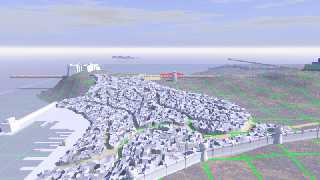|
 |
On 2-8-2011 0:29, Christian Froeschlin wrote:
> Instead of averaging with the cell pattern you could multiply the
> cell function value with coarsely sampled evaluations of the original
> height_field image. That would give "city blocks" of constant height
> appropriate for local average terrain. It will introduce steps on
> roofs that fall on a cell boundary but maybe it looks like an
> intended structure ;)
>
Well, this is not as simple as it seems, or I am doing something wrong
(probably).
I wrote a simple test code which I think explains things. Just insert it
in a basic scene:
//Start code
#declare HF_pig =
pigment {
image_map {
png "plasma3.png"
}
rotate -90*x
}
#declare F_cells =
function {
pigment {
cells
color_map {
[0.1 rgb 0.4]
[0.9 rgb 0.6]
}
//warp {turbulence <0.1, 0, 0.1>}
scale 0.03
}
}
#declare F_HF_00 =
function {
pigment {
image_map {
png "plasma3.png" gamma 1.0
map_type 0
interpolate 2
}
}
}
#declare F_flatroof =
function {
F_cells(x,y,z).hf
* F_HF_00 (x,y,z).hf
}
#declare hf_cut =
intersection {
height_field {
function 500, 500 {F_flatroof(x,y,z)}
smooth
translate <-0.5, 0, -0.5>
scale <10, 1, 10>
}
box {
<-0.5, -0.5, -0.5>, <0.5, 0.5, 0.5>
scale <10, 1, 10> * <0.99, 20, 0.99>
}
translate 1.0*y
}
intersection {
object {hf_cut}
box {
<-0.5, -0.5, -0.5>, <0.5, 0.5, 0.5>
scale <3, 10, 5>
rotate 45*y
}
pigment {rgbt <1,1,0,0.1>}
}
//----------------------------------------------------------
intersection {
height_field {
function 1000, 1000 {F_HF_00(x,y,z).hf}
smooth
pigment {HF_pig}
translate <-0.5, 0.0, -0.5>
scale <10, 1, 10>
}
box {
<-0.5, -0.5, -0.5>, <0.5, 0.5, 0.5>
scale <10, 1, 10> * <0.99, 10, 0.99>
}
}
//End code
Thomas
Post a reply to this message
|
 |
|
 |
On 5-8-2011 0:35, Christian Froeschlin wrote:
> Nice ;)
>
> My impression is that there is not enough space between houses.
> There should probably be a fine scale road system, either painted
> by hand or zeroed using some sort of crackle pattern.
True, although the particular society of Gancaloon is based on this
closely built environment ;-)
Still, I was already working on a bit more open urbanism, like this image.
Note that I *added* the cell function instead of *multiplying* it. The
results are better because in the latter case the geometry of the
cutting function is changed in the y direction.
Thomas
Post a reply to this message
Attachments:
Download 'gancaloon.png' (409 KB)
Preview of image 'gancaloon.png'

|
 |
|
 |
> Nice ;)
>
> My impression is that there is not enough space between houses.
> There should probably be a fine scale road system, either painted
> by hand or zeroed using some sort of crackle pattern.
Keep in mind that it's a medieval style walled city. In those citys,
space is *scarse*! Buildings are literaly cramed toghether leaving only
the bare minimum space for the narow and twisting streets. Buildings
overhanging over the streets are relatively to very common. Facing
buildings may actualy touch each others. This makes for prety dark
streets and aleys.
Over time, as old buildings are torn down and new ones built, the
streets tend to become narower. Some streets become dead ends, and
former dead ends may now allow thru trafic. In the worst case, some
streets or group of streets can become totaly cut off from all other
streets... In that case, you may have some "tunels" through some
buildings, or strange bridges passing over buildings.
If the terrain is steep, some "streets" can actualy be stairs.
Post a reply to this message
|
 |




![]()